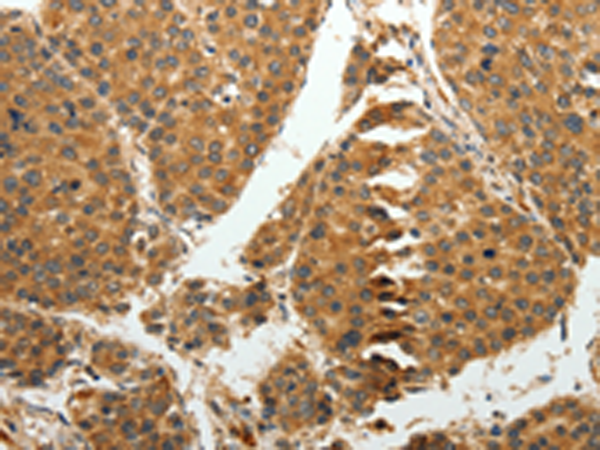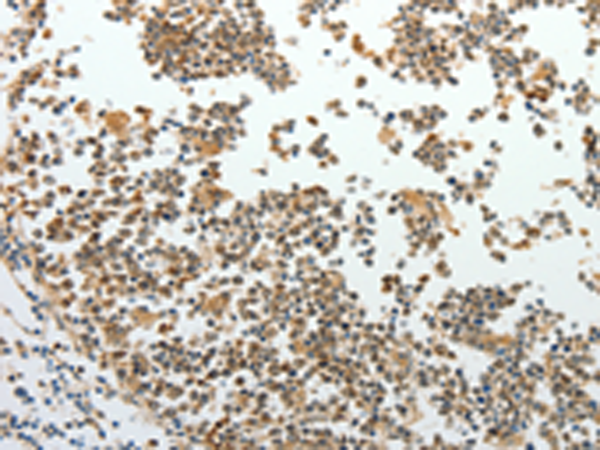


| WB | 咨询技术 | Human,Mouse,Rat |
| IF | 咨询技术 | Human,Mouse,Rat |
| IHC | 1/25-1/100 | Human,Mouse,Rat |
| ICC | 技术咨询 | Human,Mouse,Rat |
| FCM | 咨询技术 | Human,Mouse,Rat |
| Elisa | 1/1000-1/2000 | Human,Mouse,Rat |
| Aliases | R1; RR1; RIR1 |
| WB Predicted band size | 90 kDa |
| Host/Isotype | Rabbit IgG |
| Antibody Type | Primary antibody |
| Storage | Store at 4°C short term. Aliquot and store at -20°C long term. Avoid freeze/thaw cycles. |
| Species Reactivity | Human, Mouse |
| Immunogen | Fusion protein of human RRM1 |
| Formulation | Purified antibody in PBS with 0.05% sodium azide and 50% glycerol. |
+ +
以下是关于RRM1抗体的3篇代表性文献及其摘要概括:
---
1. **文献名称**:*RRM1 and PTEN as prognostic parameters in non-small cell lung cancer*
**作者**:Zheng Z, et al.
**摘要内容**:该研究通过免疫组化(使用RRM1抗体)检测非小细胞肺癌(NSCLC)组织中RRM1蛋白表达水平,发现RRM1高表达与患者对吉西他滨化疗耐药性相关,且与PTEN低表达共同提示更差的生存预后。
2. **文献名称**:*Predictive value of RRM1 and ERCC1 expression in pancreatic cancer patients treated with gemcitabine-based chemotherapy*
**作者**:Akita H, et al.
**摘要内容**:研究利用RRM1抗体进行Western blot和免疫组化分析胰腺癌组织,证实RRM1过表达是吉西他滨疗效的独立负向预测因子,为个体化化疗方案选择提供依据。
3. **文献名称**:*RRM1 as a novel prognostic marker in colorectal cancer*
**作者**:Davidson JD, et al.
**摘要内容**:通过RRM1抗体检测结直肠癌患者肿瘤样本,发现RRM1高表达与5-FU化疗耐药显著相关,并提示该标志物可能用于优化辅助化疗策略。
---
以上文献均聚焦于RRM1抗体在癌症预后评估及化疗耐药机制研究中的应用,核心结论为RRM1表达水平与患者治疗反应和生存率密切相关。
The Ribonucleotide Reductase Catalytic Subunit M1 (RRM1) is a critical enzyme component involved in DNA synthesis and repair by catalyzing the conversion of ribonucleotides to deoxyribonucleotides. As a regulatory subunit of ribonucleotide reductase, RRM1 plays a central role in maintaining genomic stability and controlling cell cycle progression. Over the past two decades, RRM1 has gained attention in cancer research due to its dual role as both a tumor suppressor and a predictor of chemoresistance. Elevated RRM1 expression is associated with resistance to nucleoside analog chemotherapeutics like gemcitabine, particularly in cancers such as non-small cell lung cancer (NSCLC), pancreatic cancer, and breast cancer.
RRM1-specific antibodies are widely used as research tools to investigate its expression patterns, subcellular localization, and interactions in both normal and malignant tissues. These antibodies enable detection via techniques such as Western blotting, immunohistochemistry (IHC), and immunofluorescence. Commercially available RRM1 antibodies are typically validated for specificity against human RRM1. often through knockout cell lines or siRNA knockdown controls. In clinical research, RRM1 antibody-based assays have been explored as potential biomarkers to stratify patients for chemotherapy or predict treatment outcomes. However, studies report conflicting data on its prognostic value, underscoring the need for standardized detection protocols. Ongoing work focuses on optimizing RRM1 antibody performance in formalin-fixed paraffin-embedded samples and elucidating post-translational modifications affecting its function.
×